I can imagine your comments e’en now as I write this. But I ought to bring Mere to your attention because it is an important club in the Manchester/Cheshire area and is currently doing a five-year stint as an Open Championship Final Qualifying Course. Former winners of tournaments at Mere include Fred Daly, Nick Faldo and Ernie Els. The club encourages local children to play golf (not just sons and daughters of members) with free tuition and sponsorship from Bentley motors. They currently field a junior team all of whom have handicaps of at worst 4 and the number of lady members who have won serious honours is considerable. The young Charlotte Wilde is currently making big strides in ladies’ amateur golf. Stay until the end. The course gradually builds up and the finale is worth experiencing.
Mere Golf and Country Club was founded in 1934 and celebrated its 75th anniversary last year. The parish of Mere was mentioned in the Domesday Book and there has been a big family estate in the area ever since. In 1652 the estate was sold to the Brooks (or Brooke) family who married into money (sugar estates in Antigua) and adopted the name Langford-Brooke. By the 1830s rambling Mere Hall had suffered fire damage and was in need of serious maintenance. It was decided to build a new hall closer to the Mere (a lake). A mock-Tudor confection was constructed with towers and turrets. The Brookes’ era ended in 1872 and the new hall also suffered from a lack of maintenance. In the 1930s it was in dreadful disrepair.
It was bought in 1934 by a consortium of local entrepreneurs, some of whom had been directors of the recently founded Marbury Hall Country Club only a few miles away. About Marbury Hall’s Country Club days I can find precious little, and nothing at all about its golf course other than its caddies were paid seriously good money. There is no trace of it today. The new directors of Mere did not intend that it should have a golf course, but would provide an airstrip, riding, fishing and other country pursuits. So the country club opened with a swimming gala.
At this time, too, a group of golfers from Timperley were about to lose their club. They could not afford the new rents being charged and went in search of new premises. (That golf course still exists as Altrincham Municipal). They approached Mere, who agreed to the building of a golf course, largely financed by the selling of plots of prime building land around the perimeter. George Duncan (who had once been professional at Timperley) was appointed professional and James Braid hired to lay out the course. If you look at the aerial you will see that the shape of the site more or less dictated the routing and until recently only one hole had been changed (by Braid). There were bound to be a lot of parallel holes.

As a country club Mere was – and still is - quite unlike anything else in the region. There were tennis, squash and swimming sections as well as golf. They could cater for large functions and a Mere wedding was quite the thing. Many tournaments involving professionals were held and there are photographs of huge crowds following play. During the Second World War Mere opened its doors to American servicemen from RAF Burton Wood which at that time was the American gateway to Europe. Eisenhower played while staying locally (in Peover) in the run up to D-Day. The Americans maintained a close relationship with Mere after the war and in the early jet era presented the club with a 6-foot model of a B-47 to be played for as a club trophy.
Mere changed significantly in 1964 when it was sold to the Rank Organisation. Subsequently it passed through a number of owners who saw it as a means of generating money, spending little on upkeep and bringing in so many visitors that members could hardly get a game. It went downhill. On 19th January 1973 a disastrous fire destroyed the hall. But in 1984 Mere was bought by Stephen Boler, a businessman who not only played golf but understood what it meant for the members. He poured a lot of money, energy and passion into the place and, following his death, his son Mark has continued in the same manner.
As a country club the facilities are impressive – 500 diners can be served at a sitting. After the fire what had been outbuildings had to be converted for locker rooms, bars, dining rooms etc. Later they were connected together by a glass-roofed atrium which provides a fine meeting area with food available all day.
The course is parkland, but on the whole drains well. There are a lot of trees, some of them of considerable age, others planted over the years to give separation to neighbouring fairways, which is something of a necessity for safety when company days or society visits bring golfers who are perhaps not the straightest hitters. The Bolers attended The Masters and there is something of the botanical garden about Mere which stems from what they saw in Augusta. And there are thousands of flowers planted each spring to provide colourful tees until they are cut down by winter frosts. Maintenance is impressive and, even in winter, the condition warrants paying what are by some way the highest visitor green fees in the area. Mere is run to be an experience and not just somewhere you play golf.
You might notice that an area of the Mere is segregated off. That is the driving range. There is no room elsewhere for a practice ground. Special floater balls are imported from the far east and most are recovered for further use. The Mere itself is a Site of Special Scientific Interest and this has important consequences for green-keeping practices.
1. 530 yards par 5
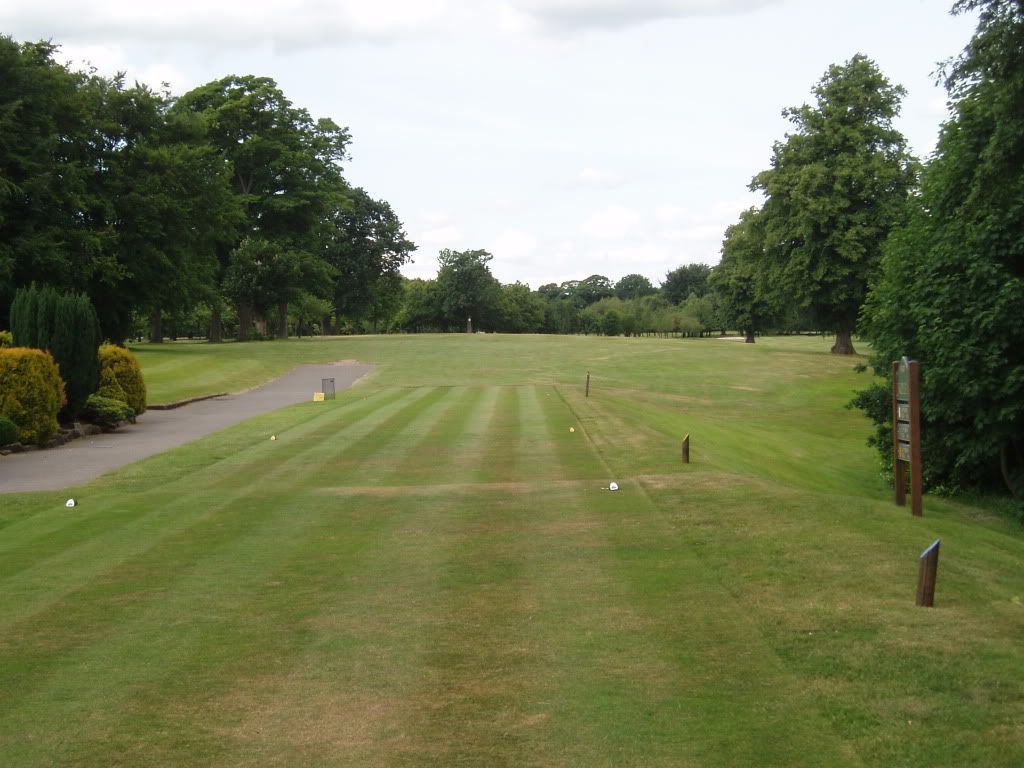
At 6817 yards to a par of 71 Mere is longer than most other courses in the neighbourhood, certainly among courses of this age or older. The 1st gives plenty of scope for opening the shoulders with the fairway un-bunkered at this stage. True, there are trees behind which you can get stuck and the Mere awaits on the right if you hit a wild slice.
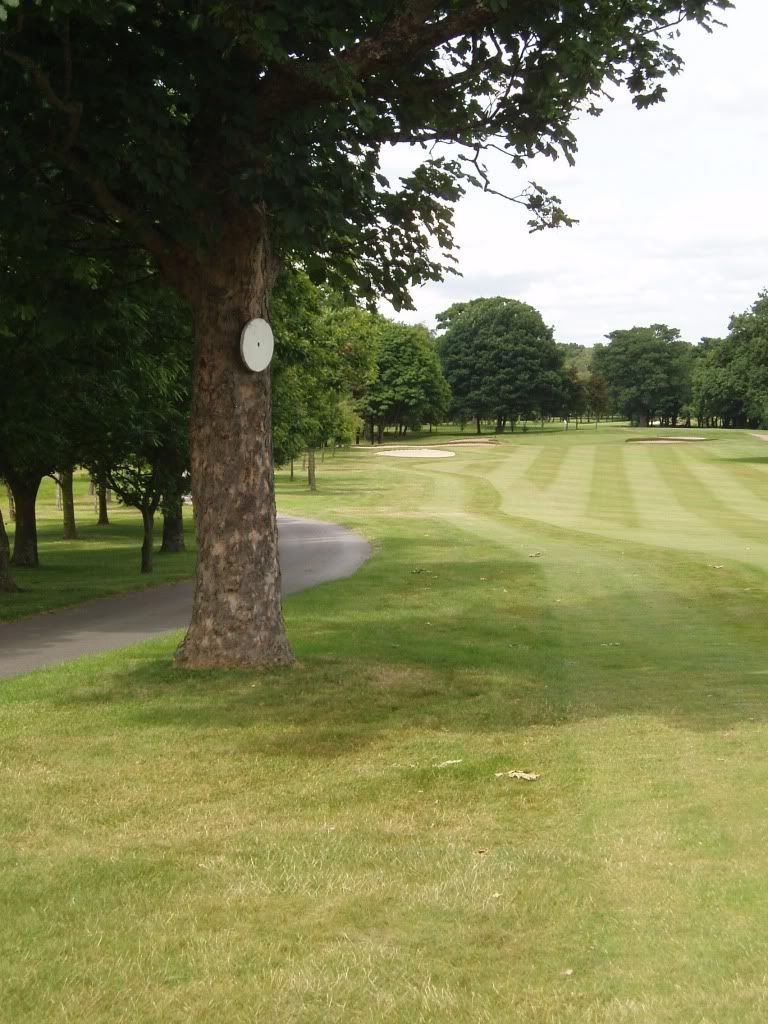
A disc on a tree 285 yards out acts as an aiming point. With a little bias to the right and a slight degree of turn, the ball will run perfectly into the centre of the fairway.
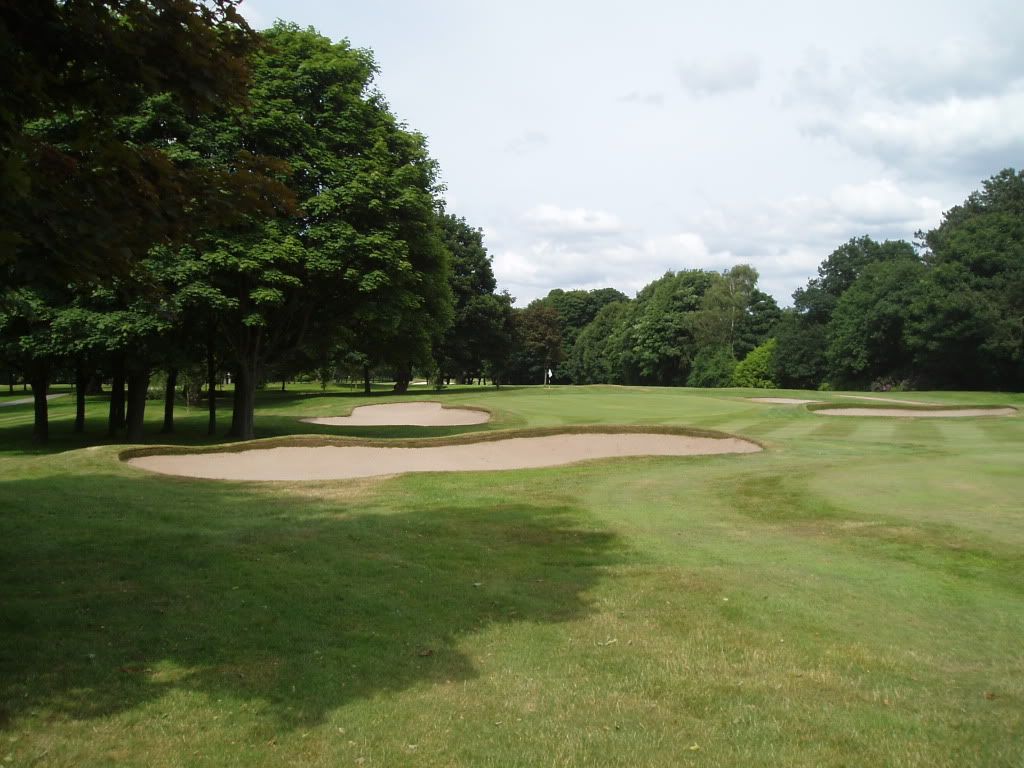
Bunkers come into play on the left over the last 80 yards. Over the years many of Braid’s pairs or trios of bunkers were made into single large ones, but there is an ongoing process of returning to their original size and number.
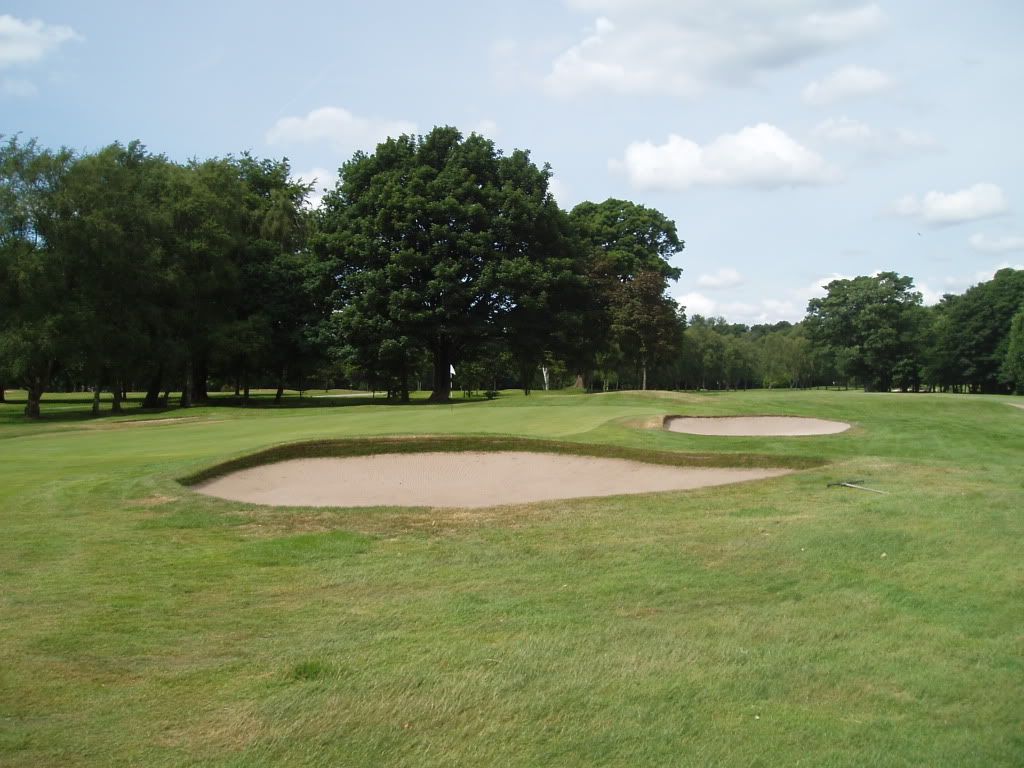
On this side of the course the ground is undeniably flat.
2. 409 yards par 4
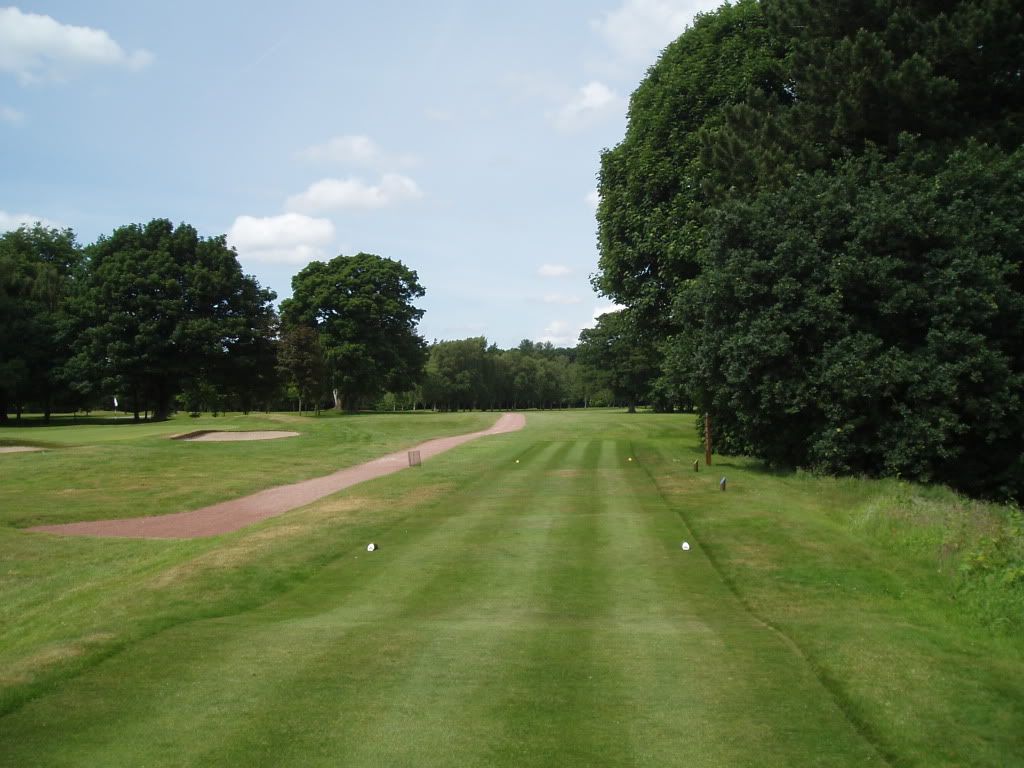
Trees threaten the tee shot on the right, but that is not the side to be with a right-handed dog-leg at good driving distance.

That’s the dog-leg and you don’t want to be stymied by the big tree on the right.

This bunker on the outside of the dog-leg is 230 yards from the tee and 179 from the green.
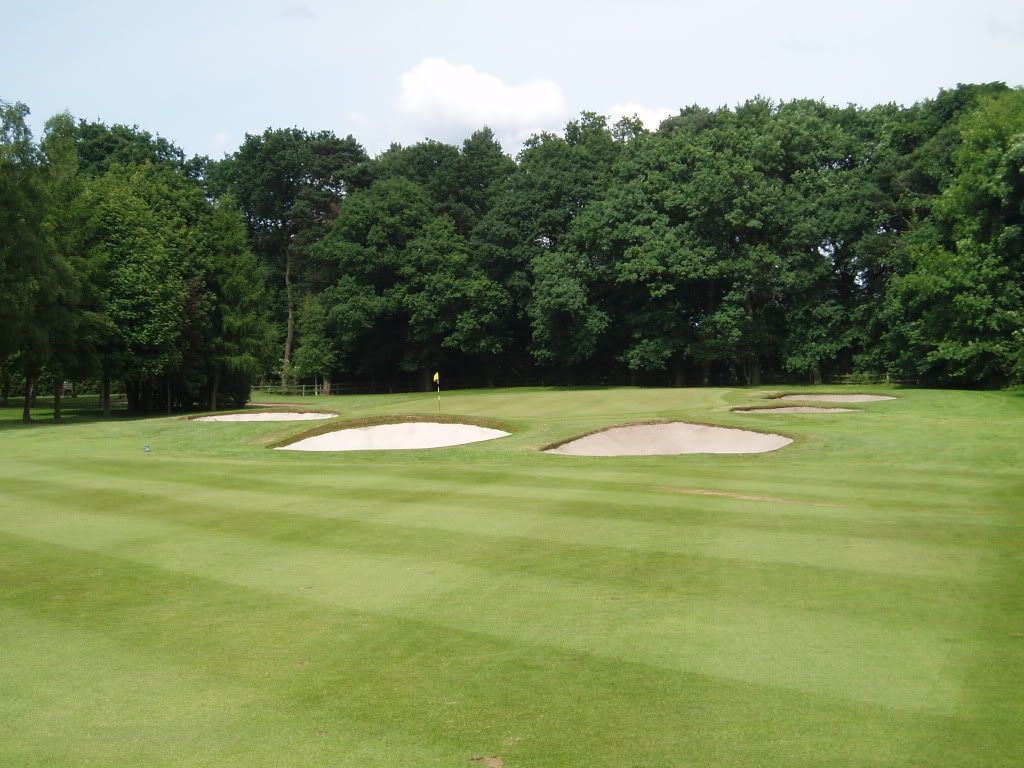
Two bunkers 50 yards in front of the green interrupt the fairway. There is also a small bunker front left and a big bunker running the length of this long, narrow green on the right.
3. 174 yards par 3
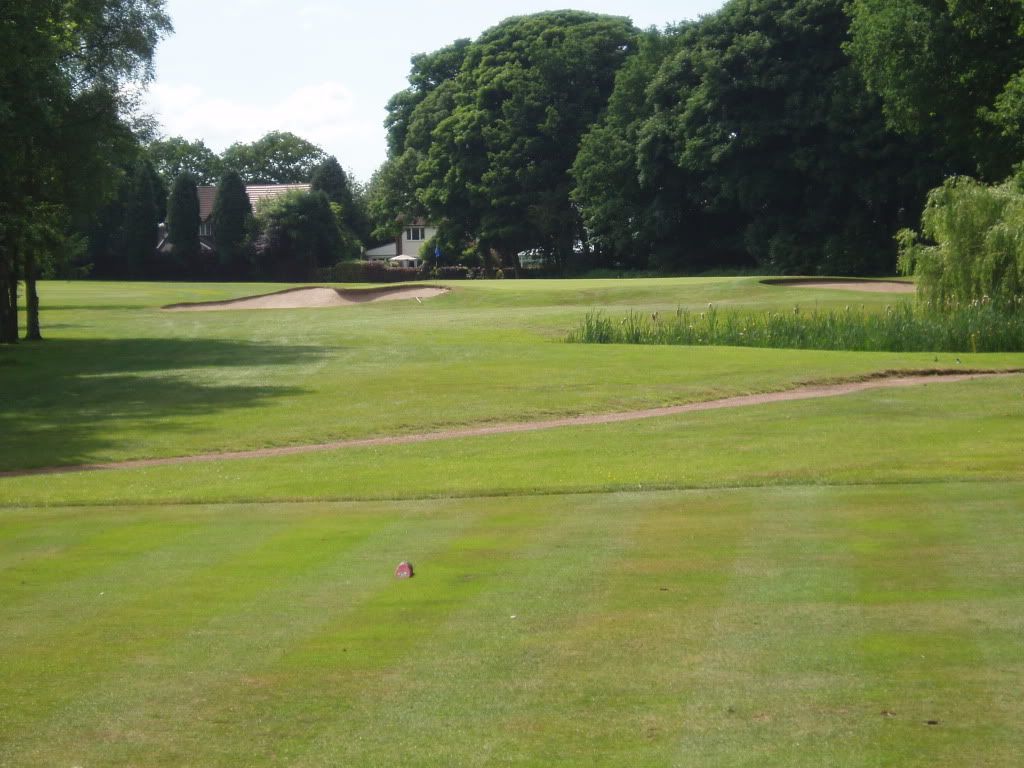
There is a pond some way short of the putting surface which may possibly have been dug to provide the material for raising the green. It is not at all out of character in this part of Cheshire where farmers dug marl pits at which their cattle watered themselves until bureaucracy intervened.

There are bunkers on both sides of the entrance to the green but there is quite a wide opening.
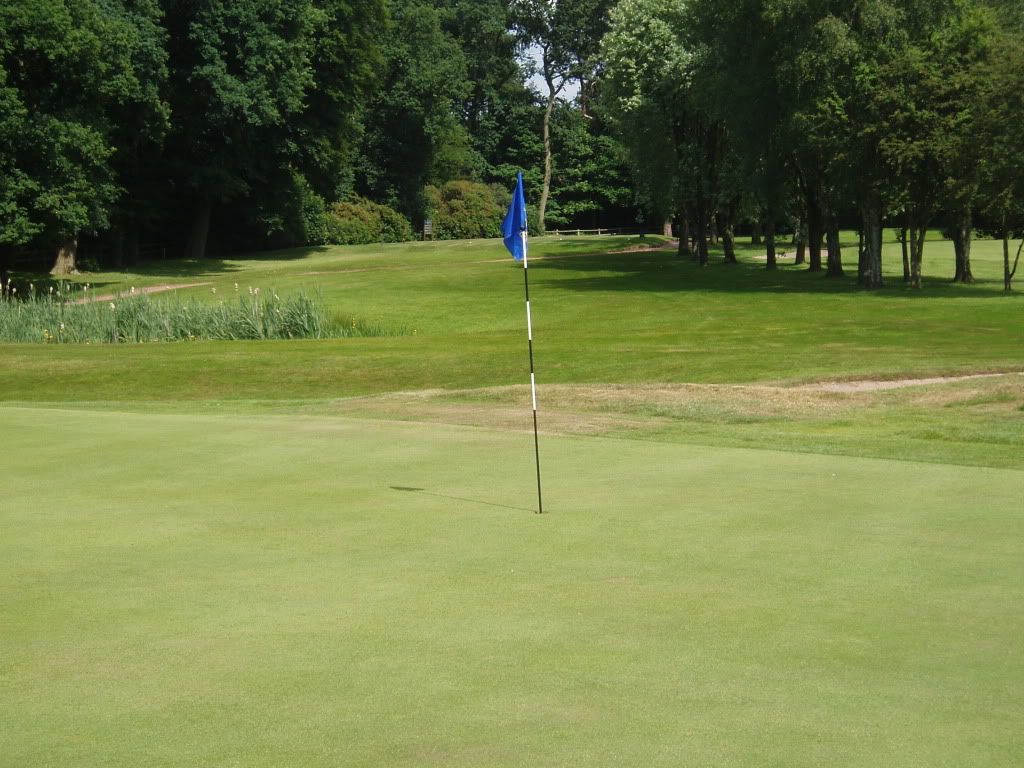
Looking back towards the tee.
4. 357 yards par 4
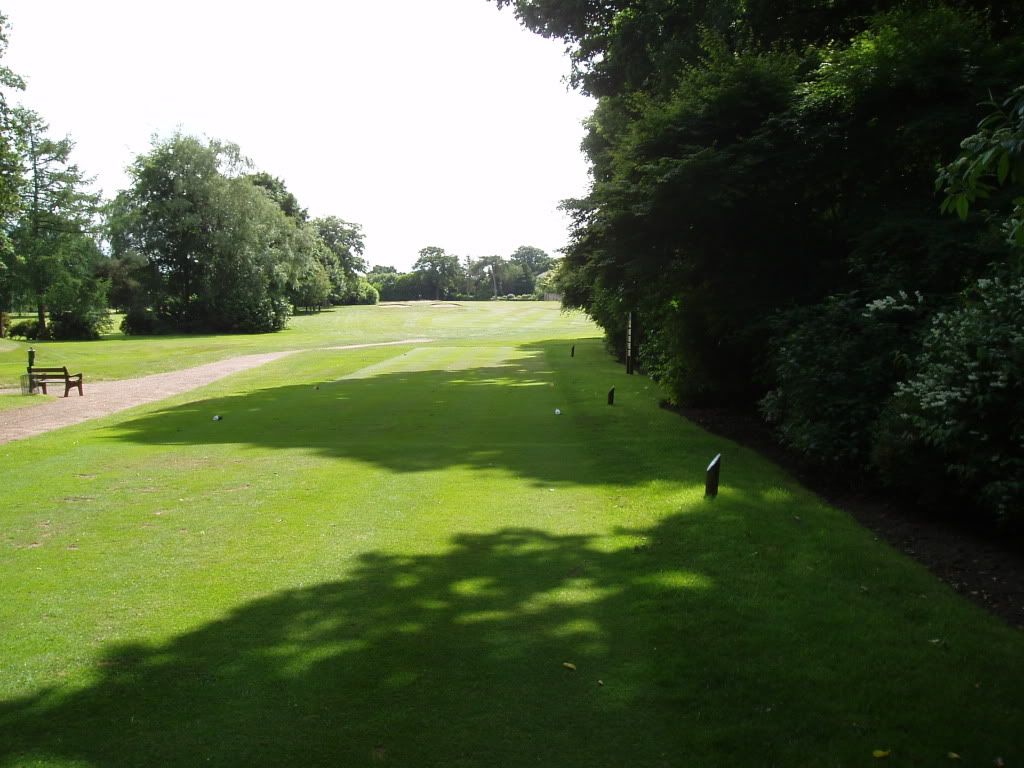
The shortest two-shotter on the course, quite sharp dog-leg to the left.

Good position where the fairway turns is imperative.
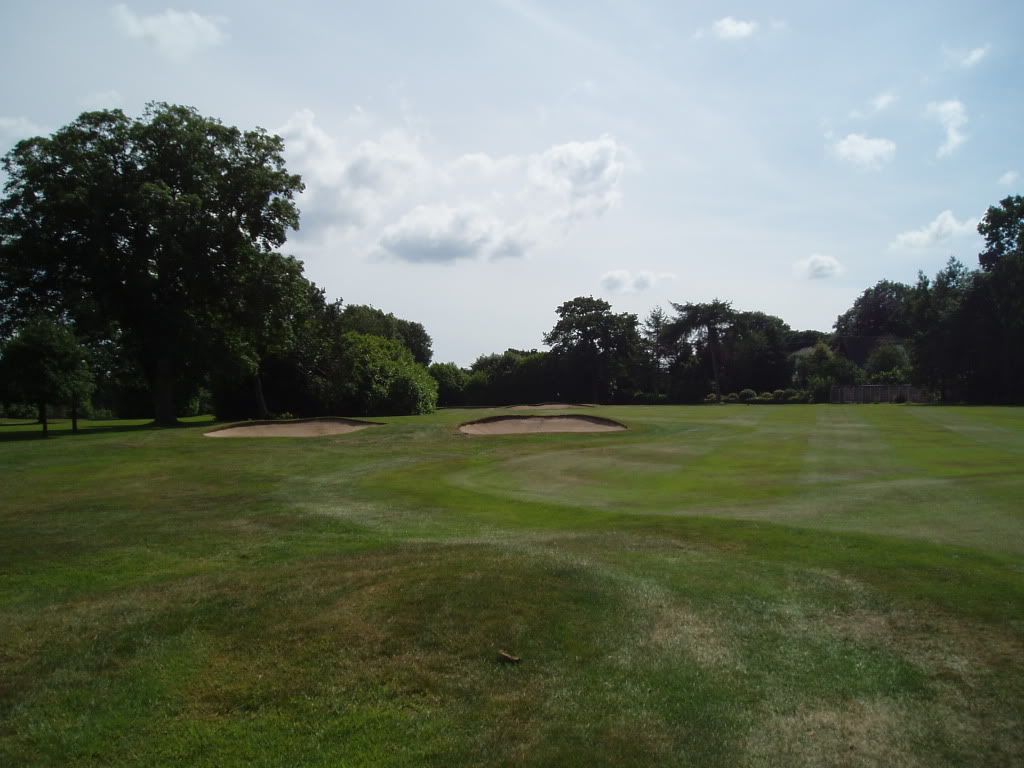
These bunkers are 235 yards from the tee, leaving 122 yards to the centre of the green. There is also a bunker a little shorter of these on the outside of the dog-leg.
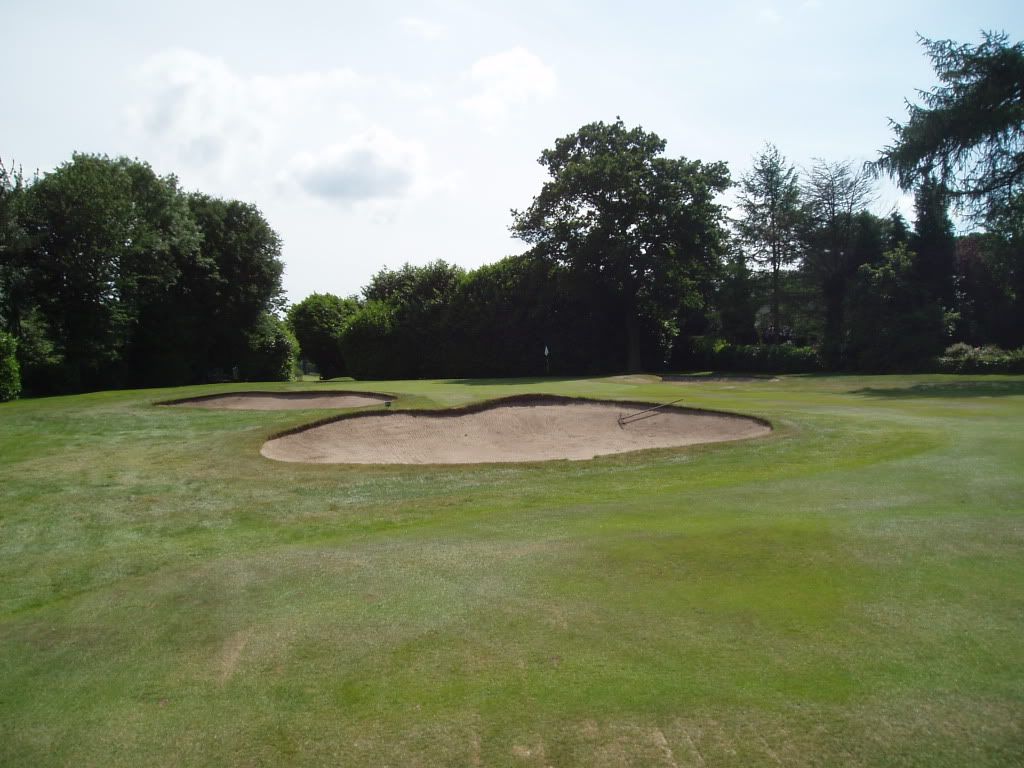
Bunkers narrow the entrance to the green, and, as at the 2nd, a bunker runs the entire length of the green on the right.

Looking back.
5. 428 yards par 4
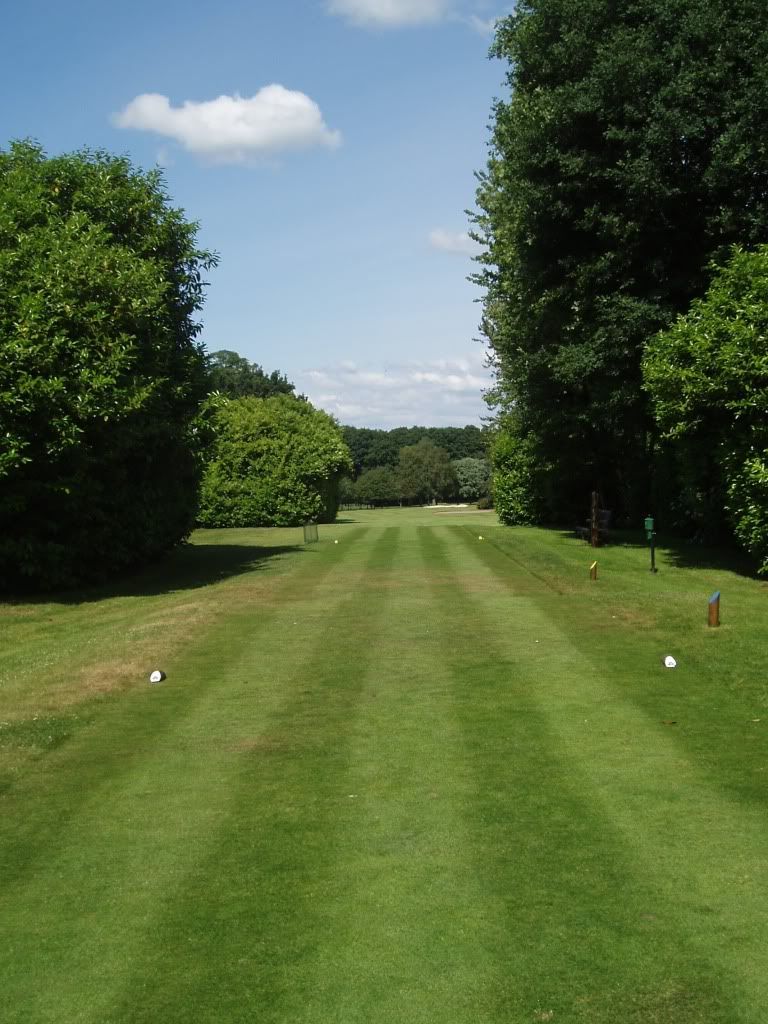
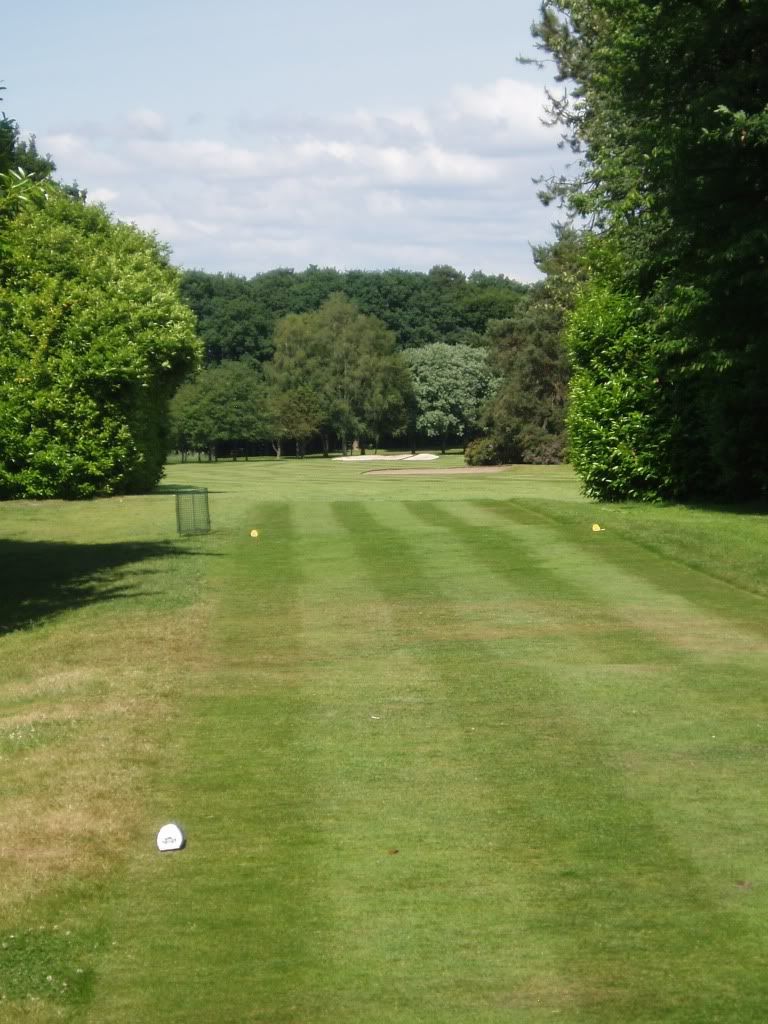
On quite a few tees at Mere there is a sense driving through a tunnel (Augusta 18th?).
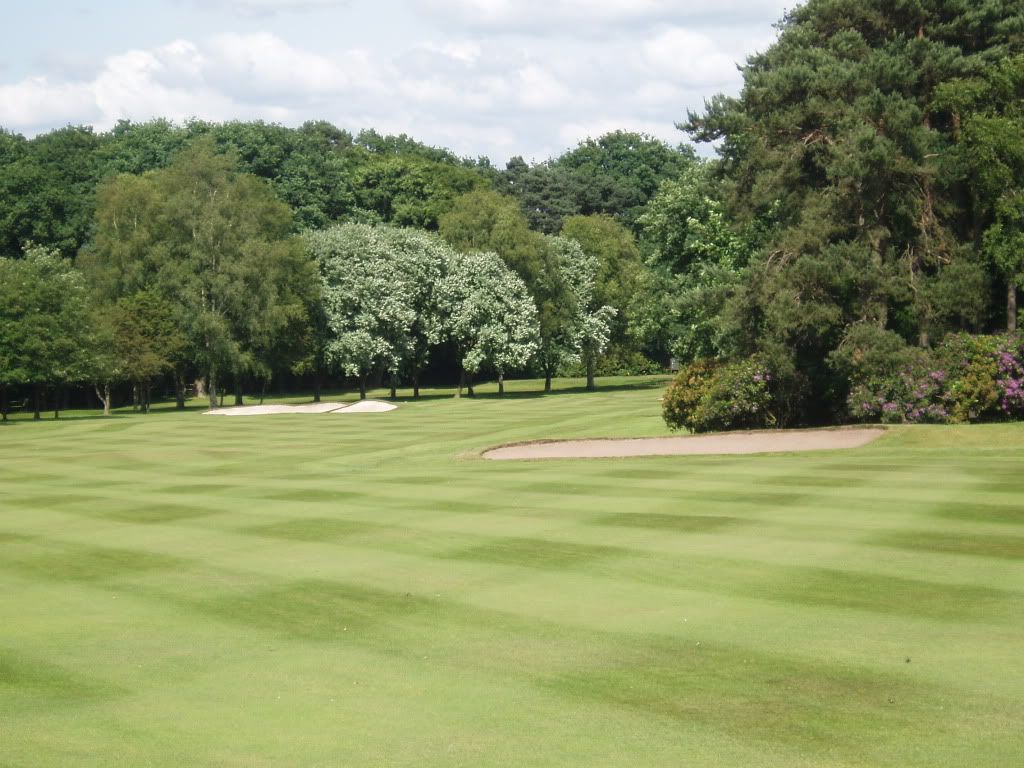
The landing zone has a pair of bunkers on the right 240 yards out and one on the left, on the outside of the dog-leg at about 275.
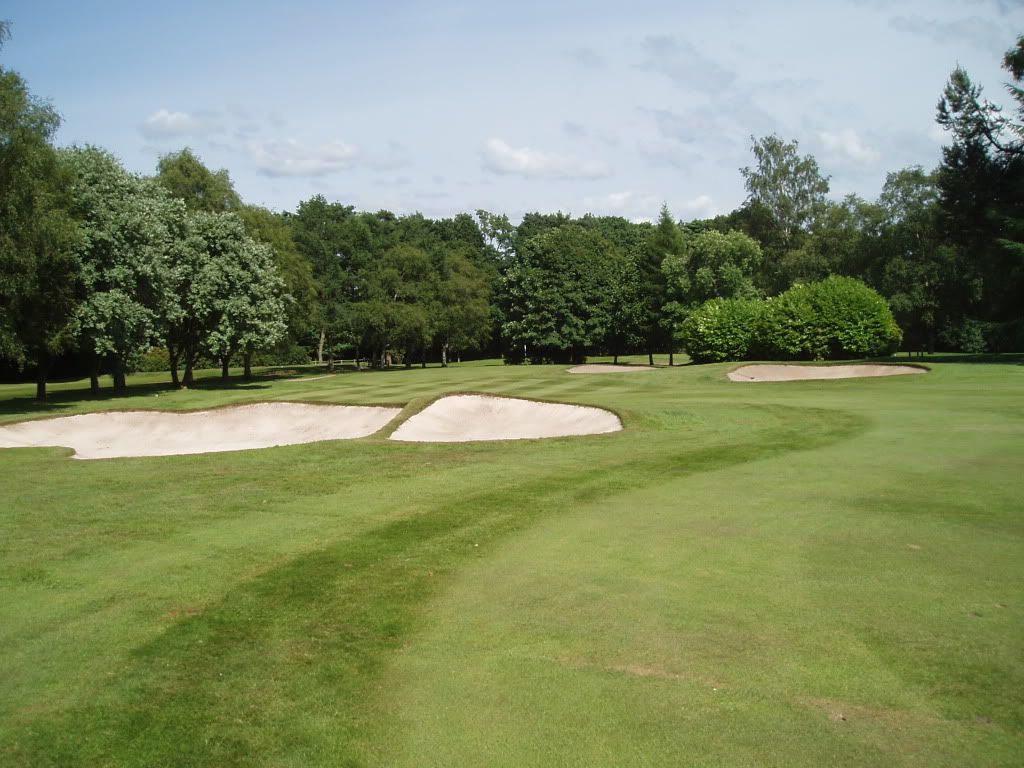
These bunkers 75 yards from the green and one on the right 50 yards from the green threaten the second shots of those who got out of position on the drive or who couldn’t drive far enough to see round the corner. Once again the green is narrow and guarded by bunkers on either side at the entrance.
6. 437 yards par 4

Another funnel-effect tee.
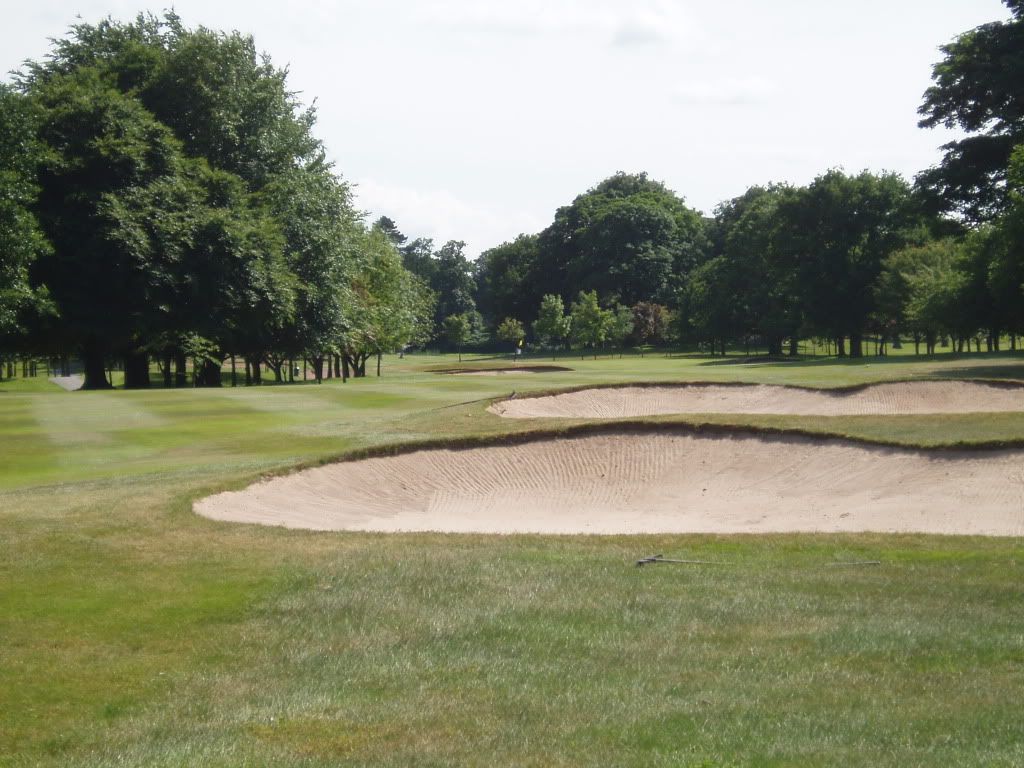
Another dog-leg, this time to the left. Good ball strikers should not be troubled by these from the tee.
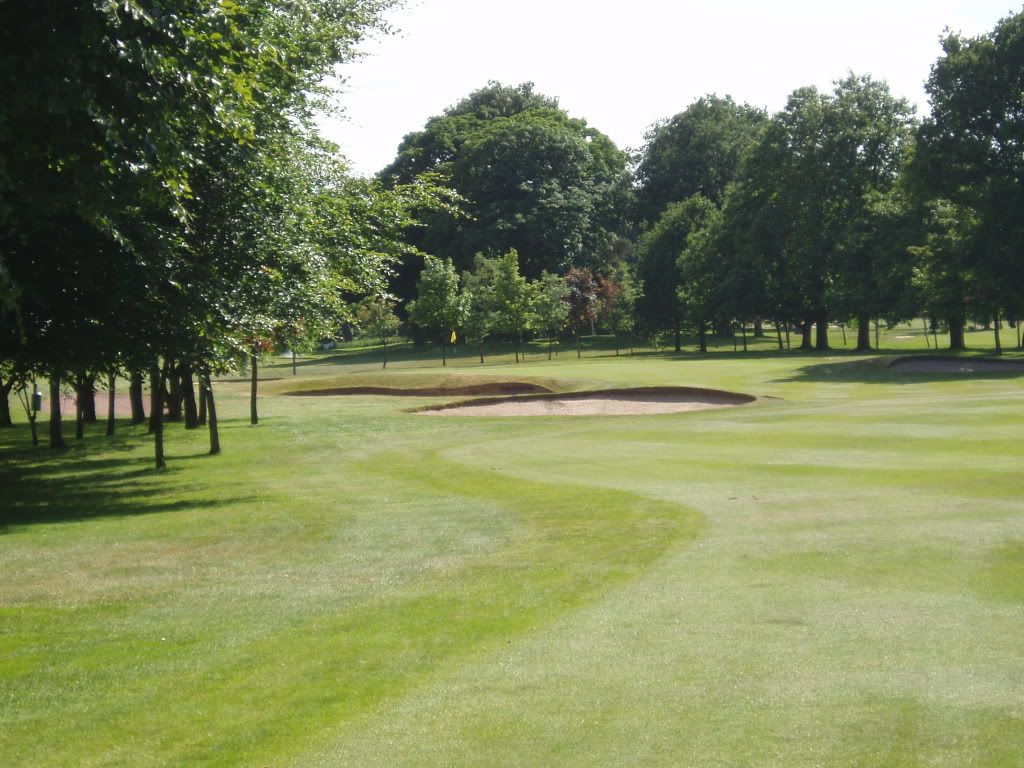
Bunkers eat into the fairway over the last 70 yards.
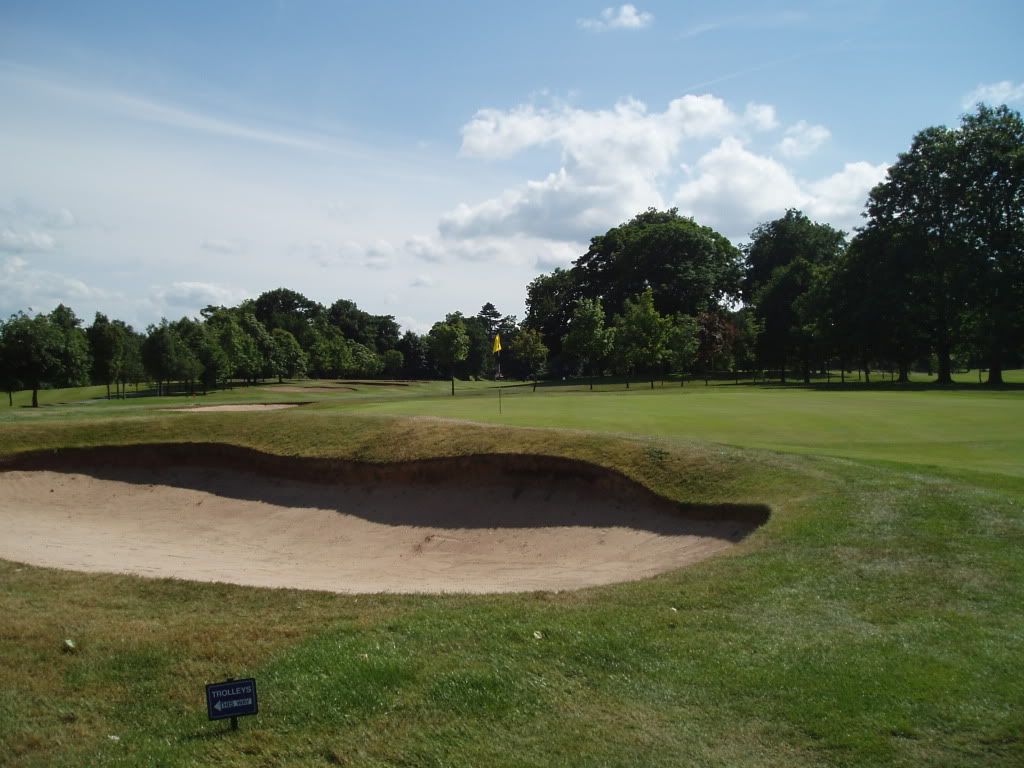
Three bunkers guard the green.
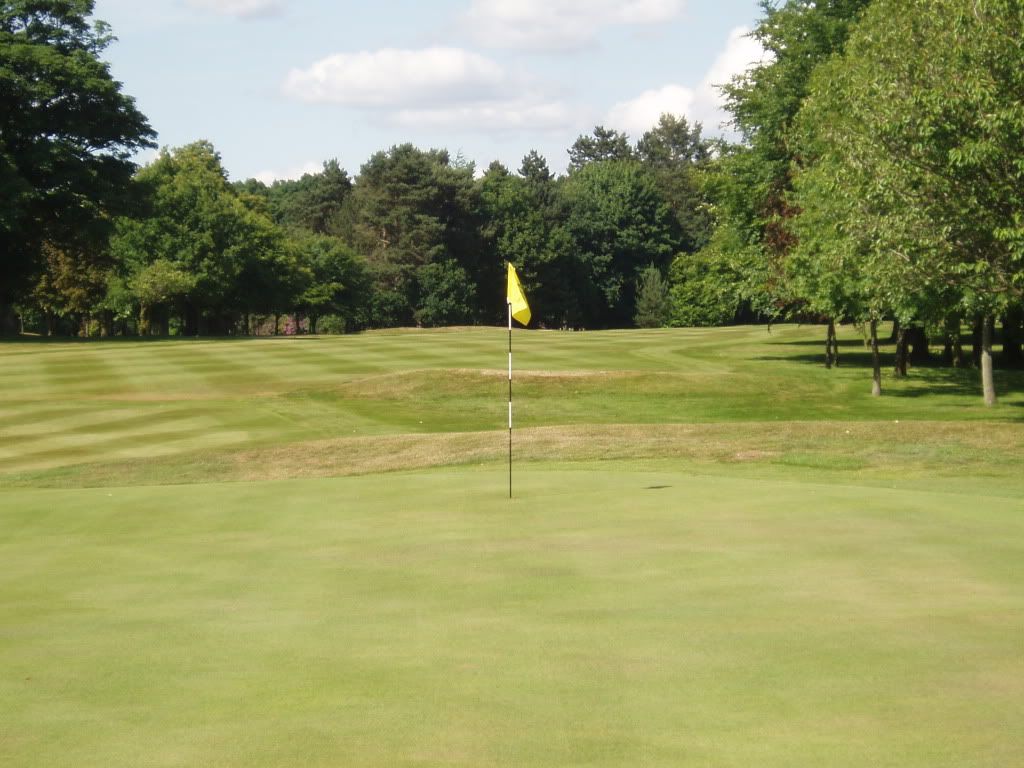
Another view from behind.
7. 402 yards par 4
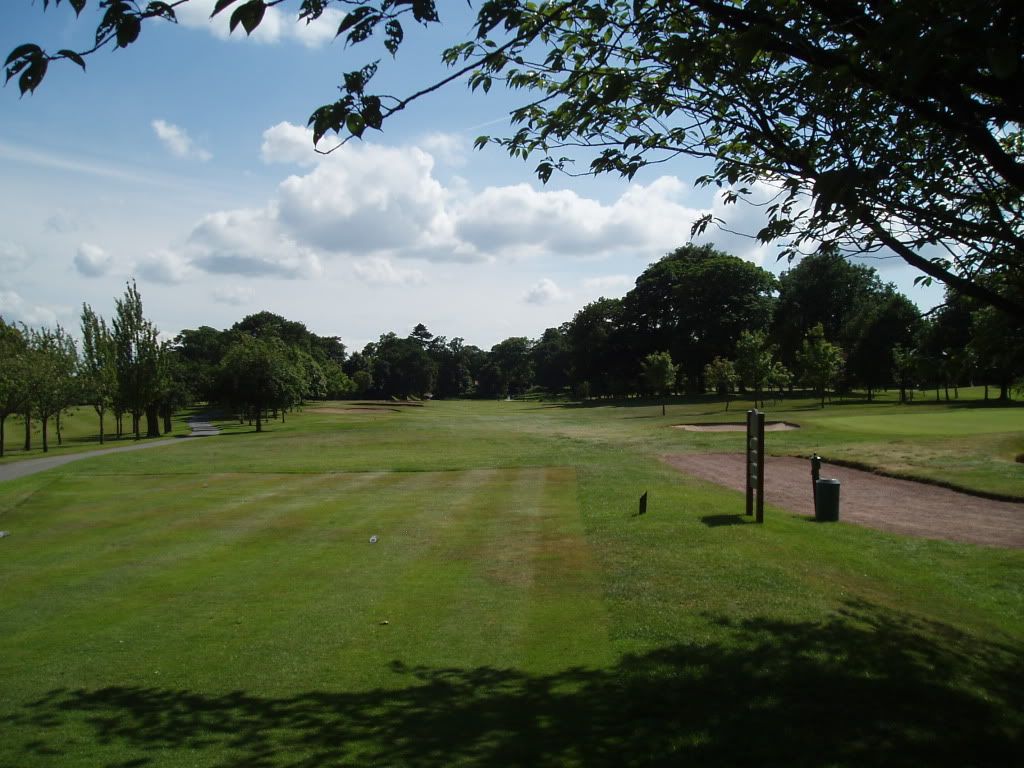
Fewer trees encroach on this fairway, but bunkers proliferate with four down the left and two on the right from 210 to 300 yards from the tee.
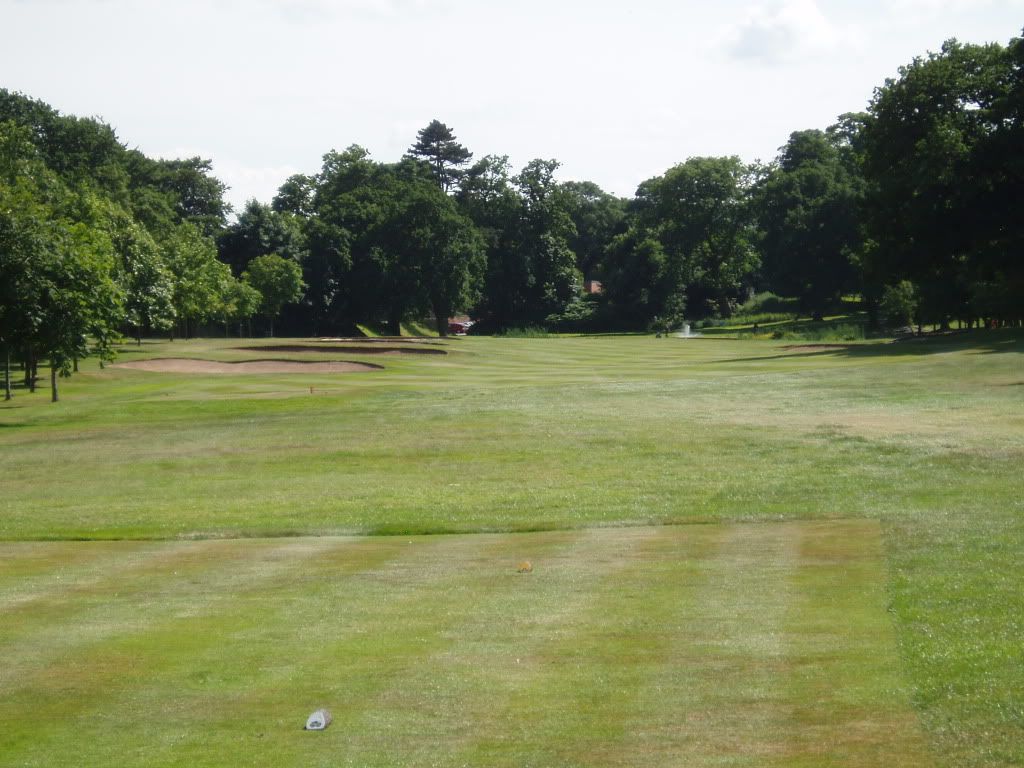
You need to make good distance from the tee because the approach shot is played over a pond to a shallow green. The pond is not Braid’s. This turned out to be a rare damp spot on the course and flooding of the green occurred from time to time. In 1954 it was proposed to raise the green but this was never done. A couple of trees also shaded the green from the sunlight so it was slow to dry out after flooding. Consequently the pond was dug and a virtue made of it.
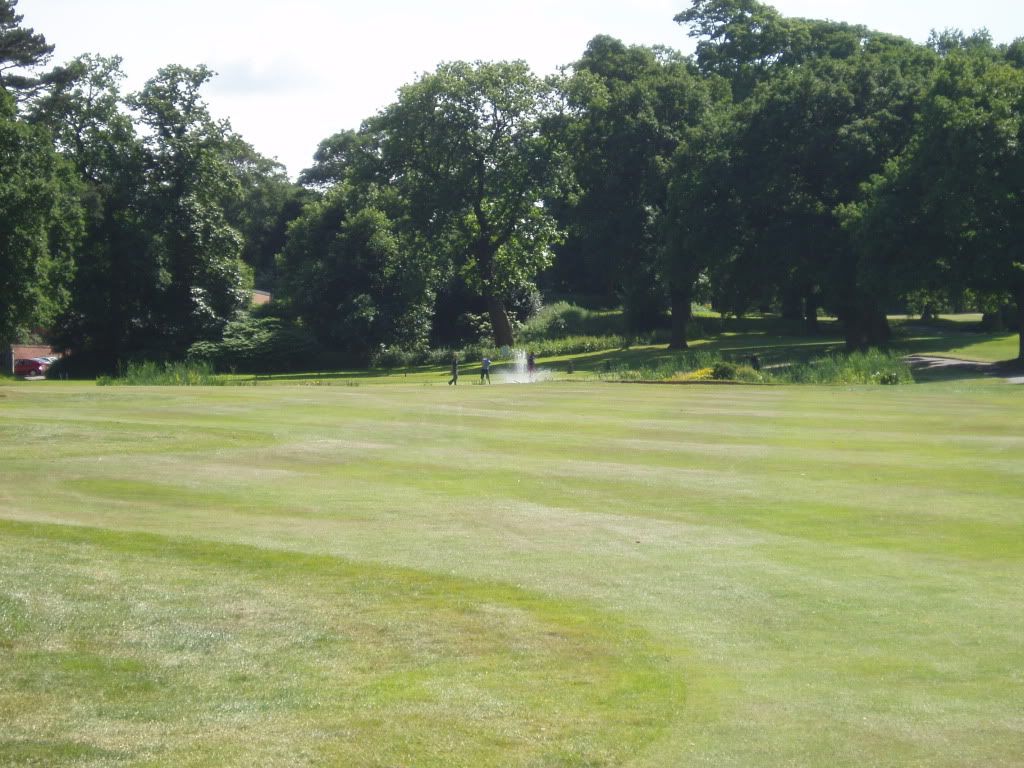
From closer.
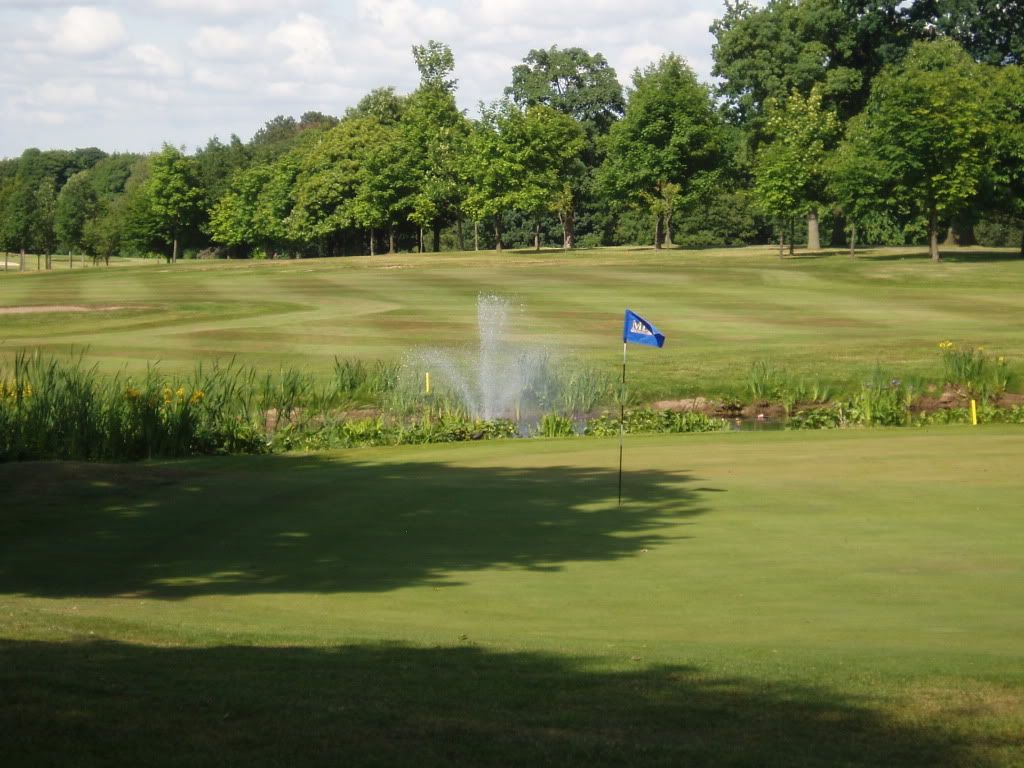
Another American influence, the fountain. Again looking back.
8. 195 yards par 3
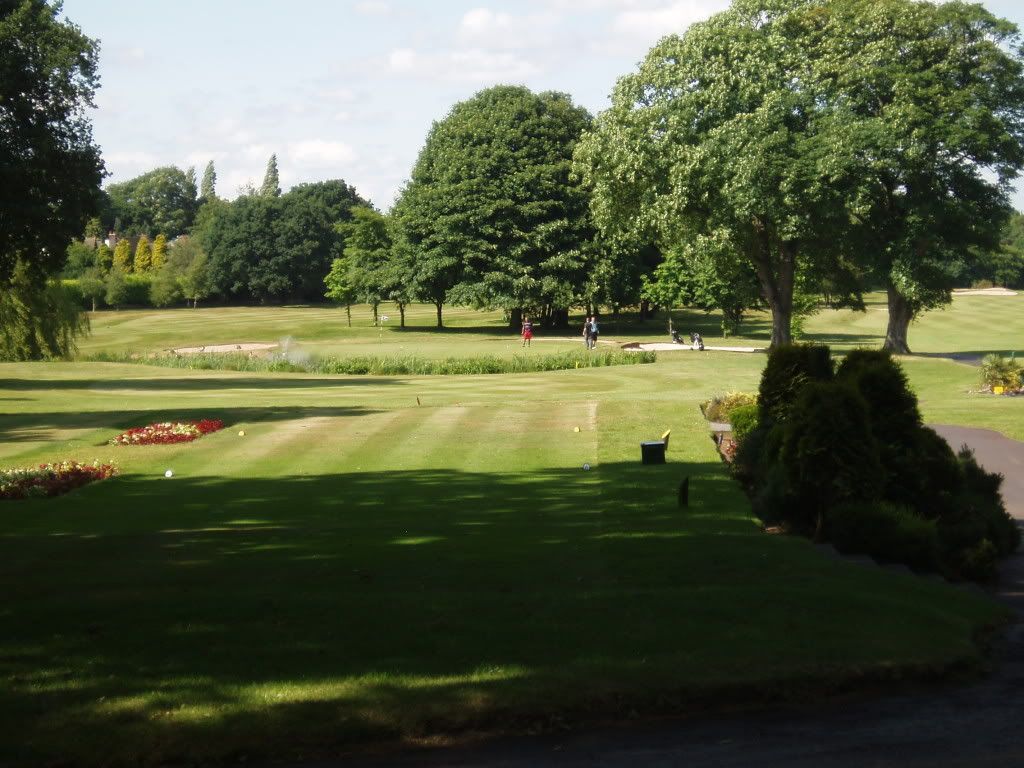
This one-shotter is played from an elevated tee across another pond which directly fronts the green. I believe this pond is also comparatively modern and, no doubt, related to the pond on the 7th.
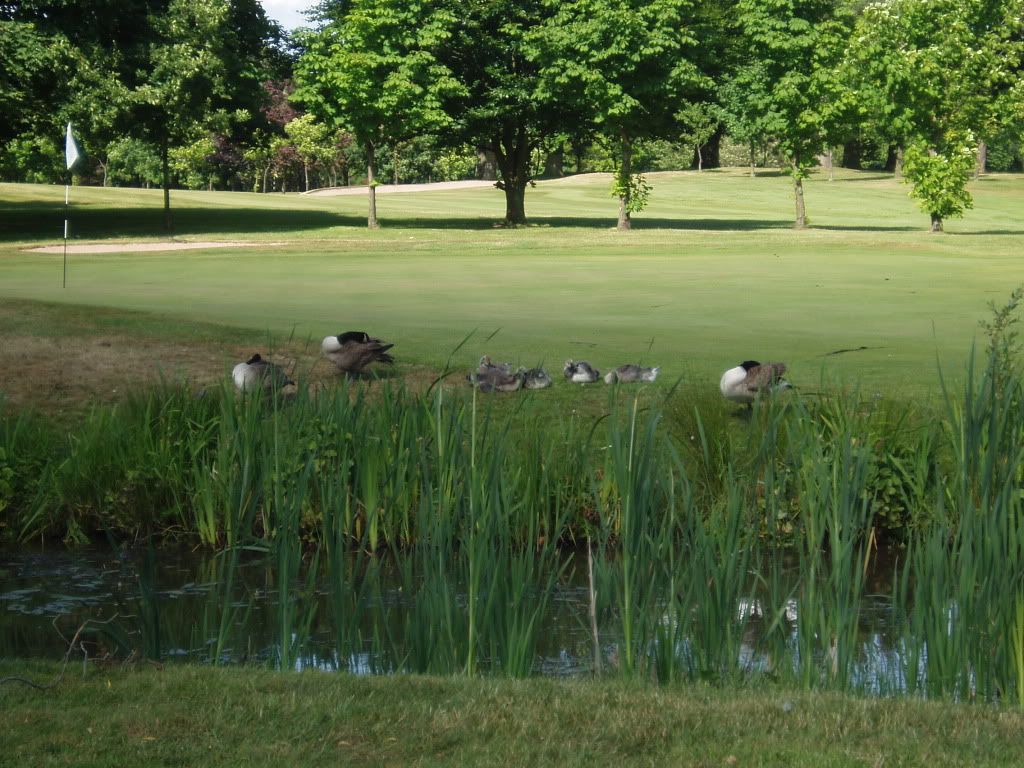
Another import from North America, Canada geese.
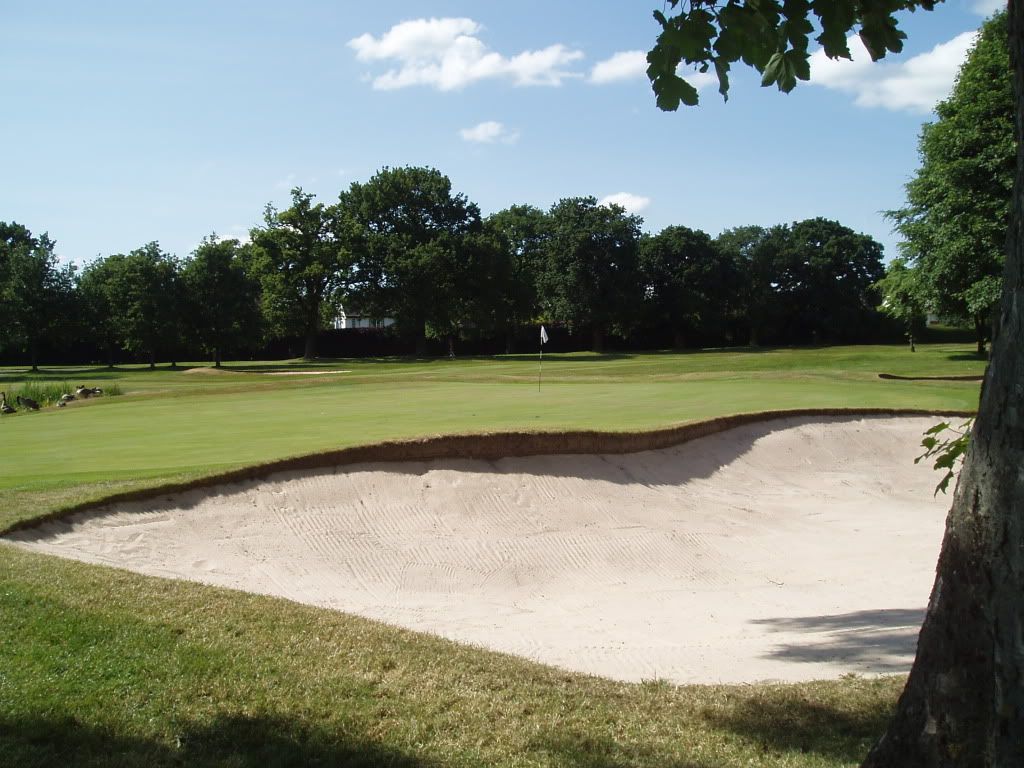
As if the pond were not enough, there are bunkers on either side of the green and one through the back.
9. 531 yards par 5
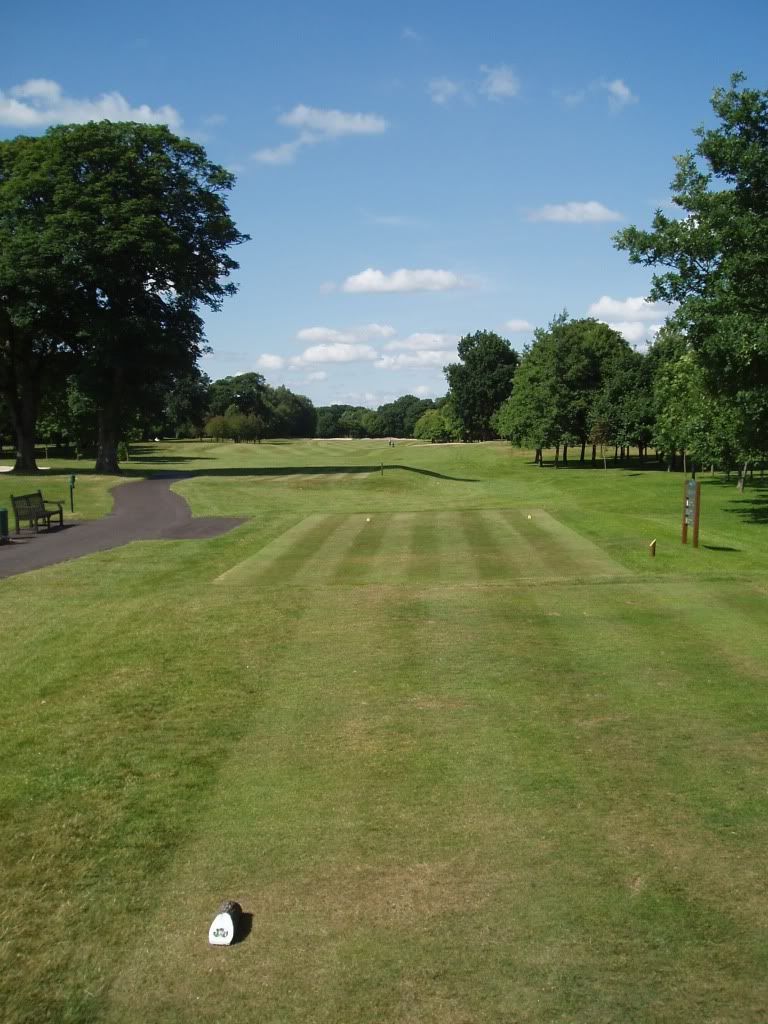
To get to this tee you walk back almost to the 8th tee and there must be a temptation to break the rules of golf by teeing off on the 8th, teeing off on the 9th, then putting out on the 8th before setting off down the 9th fairway. Both holes, when played from the back tees, cross the exit road from the clubhouse complex which must cause a few headaches when non-golfers are leaving from a function in one of the event suites.

This bunker awaits a slight pull from the tee 260 yards out from the tee. There is a slight downhill movement to this fairway which rewards long driving.
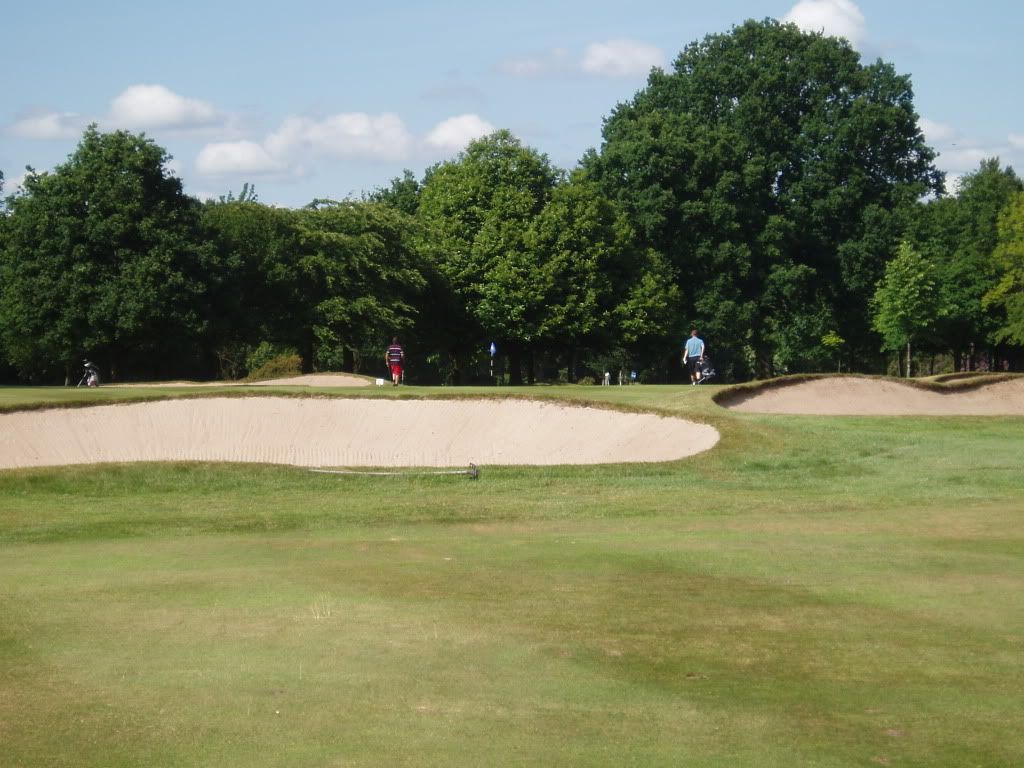
Two diagonal cross-bunkers completely sever the fairway from 115 to 80 yards short of the green. Their function is two-fold. They present a very well-placed obstacle that still causes most golfers to have to think whether or not they can get past them in two shots. But they also greatly foreshorten the view of the green making it seem much closer to the bunkers than it is in reality.
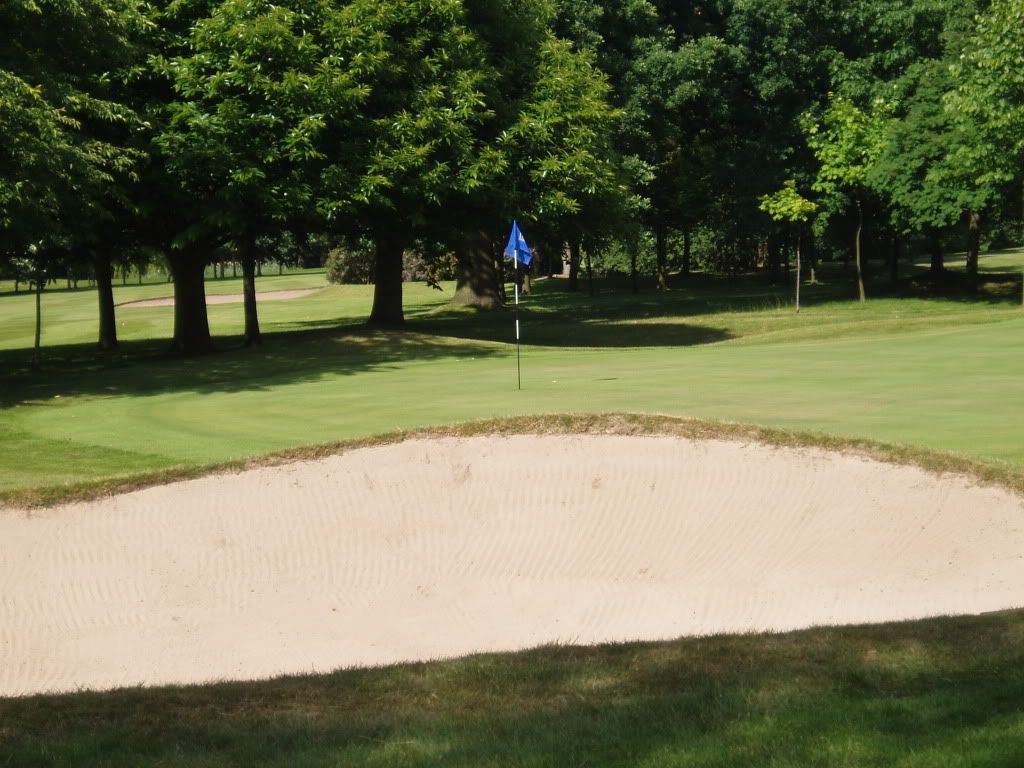
This big bunker guards the entire right side of the green. The putting surface slopes quite a bit from left to right.